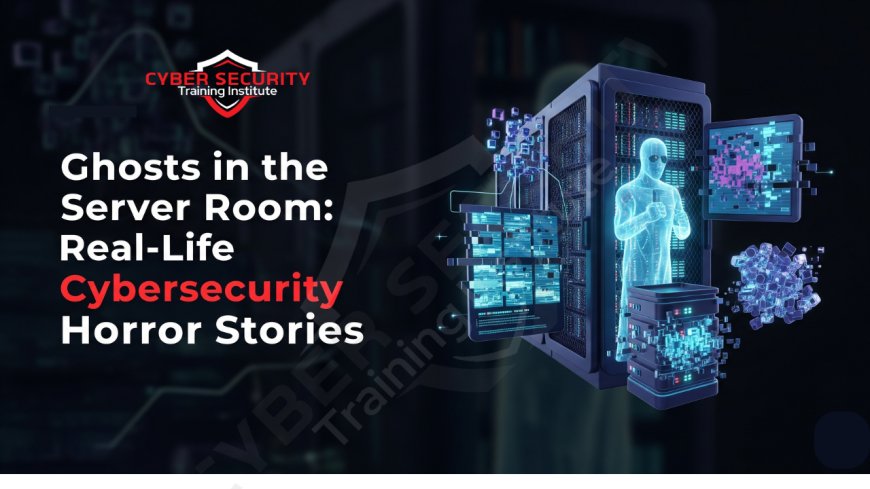Ghosts in the Server Room | Real-Life Cybersecurity Horror Stories
In the quiet hum of a server room, where blinking lights and whirring fans create a sense of calm, invisible threats lurk. Cybersecurity breaches are the modern-day ghosts haunting businesses, governments, and individuals alike. These incidents can cost millions, ruin reputations, and even compromise national security. In this blog post, we dive into real-life cybersecurity horror stories that serve as cautionary tales. From massive data breaches to insider threats, these stories highlight the importance of vigilance in our digital world. Whether you’re a tech newbie or a seasoned IT professional, these accounts will make you think twice about the security of your systems.

Table of Contents
- The Equifax Nightmare: A Data Breach Disaster
- The Target Hack: A Retail Giant’s Downfall
- The Insider Threat: A Rogue Employee’s Betrayal
- The Ransomware Siege: WannaCry’s Global Rampage
- Lessons Learned from These Horror Stories
- Conclusion
- Frequently Asked Questions
The Equifax Nightmare: A Data Breach Disaster
In 2017, Equifax, one of the largest credit reporting agencies in the world, suffered a breach that exposed the personal information of 147 million people. This included names, Social Security numbers, birth dates, and addresses—sensitive data that could fuel identity theft for years.
The breach began when hackers exploited a vulnerability in Apache Struts, a software framework Equifax used. The company had been warned about the vulnerability months earlier but failed to patch it in time. Hackers slipped through this crack, accessing systems for months before being detected. The fallout was catastrophic: Equifax faced lawsuits, regulatory fines, and a tarnished reputation.
| Incident | Impact | Lesson |
|---|---|---|
| Equifax Data Breach (2017) | 147 million people’s data exposed | Patch systems promptly to close vulnerabilities |
This incident underscores the importance of timely software updates. A simple patch could have prevented a disaster that affected millions.
The Target Hack: A Retail Giant’s Downfall
In 2013, retail giant Target became the victim of a massive cyberattack during the busy holiday shopping season. Hackers stole credit and debit card information from 40 million customers and personal details from 70 million others. The breach began with a phishing email sent to a third-party vendor that maintained Target’s heating and cooling systems.
The hackers used stolen credentials to access Target’s network, then moved laterally to reach the point-of-sale systems. Despite having security measures in place, Target’s failure to segment its network allowed the attackers to roam freely. The company paid over $200 million in settlements and faced a significant drop in customer trust.
| Incident | Impact | Lesson |
|---|---|---|
| Target Data Breach (2013) | 40 million card details, 70 million personal records stolen | Secure third-party vendors and segment networks |
This story highlights the dangers of weak third-party security and the need for robust network segmentation to limit damage.
The Insider Threat: A Rogue Employee’s Betrayal
Not all cybersecurity threats come from external hackers. In 2018, a disgruntled Tesla employee sabotaged the company’s manufacturing systems. The employee, upset over being passed for a promotion, altered code in Tesla’s systems and leaked sensitive data to third parties.
This insider threat went undetected for weeks, as the employee had legitimate access to critical systems. The sabotage could have disrupted Tesla’s production lines, costing millions. Fortunately, the company’s internal monitoring systems eventually flagged the suspicious activity, and the employee was caught.
| Incident | Impact | Lesson |
|---|---|---|
| Tesla Insider Threat (2018) | Code sabotage, data leaks | Monitor employee access and behavior |
Insider threats remind us that trust must be balanced with oversight. Monitoring systems can catch suspicious behavior before it escalates.
The Ransomware Siege: WannaCry’s Global Rampage
In 2017, the WannaCry ransomware attack infected over 200,000 computers across 150 countries. This malicious software locked users out of their systems, demanding Bitcoin payments to restore access. The attack hit hospitals, businesses, and government agencies, causing widespread disruption.
WannaCry exploited a Windows vulnerability that had been patched by Microsoft months earlier. However, many organizations hadn’t updated their systems, leaving them exposed. The UK’s National Health Service was hit hard, with hospitals unable to access patient records, leading to canceled surgeries and delayed care.
| Incident | Impact | Lesson |
|---|---|---|
| WannaCry Ransomware (2017) | 200,000+ systems infected globally | Keep systems updated and back up data regularly |
WannaCry showed how devastating ransomware can be and why regular backups and updates are non-negotiable.
Lessons Learned from These Horror Stories
These cybersecurity horror stories share common themes that every organization and individual can learn from. Below is a summary of key statistics from these incidents, followed by actionable lessons:
| Incident | Year | Records Affected | Estimated Cost |
|---|---|---|---|
| Equifax Data Breach | 2017 | 147 million | $1.4 billion |
| Target Data Breach | 2013 | 110 million | $200 million |
| Tesla Insider Threat | 2018 | Unknown | Potential millions |
| WannaCry Ransomware | 2017 | 200,000+ systems | $4 billion globally |
- Patch Promptly: Delays in updating software can leave systems vulnerable, as seen in the Equifax and WannaCry cases.
- Secure Third Parties: The Target hack shows that vendors can be a weak link. Ensure partners follow strict security protocols.
- Monitor Insiders: The Tesla incident proves that employees can pose risks. Use monitoring tools to detect unusual activity.
- Backup Data: Regular backups can mitigate ransomware damage, as WannaCry victims learned the hard way.
- Educate Employees: Phishing emails, like the one in the Target breach, exploit human error. Training can reduce risks.
By applying these lessons, businesses and individuals can avoid becoming the next cybersecurity horror story.
Conclusion
The digital world is full of ghosts—cyber threats that can strike without warning. From the Equifax breach to the WannaCry ransomware, these real-life stories show the devastating consequences of lax cybersecurity. They also offer valuable lessons: patch systems promptly, secure third-party vendors, monitor insiders, back up data, and educate employees. By taking these steps, you can protect your systems and data from the unseen dangers lurking in the server room. Stay vigilant, and don’t let your organization become the next cautionary tale.
Frequently Asked Questions
What is a data breach?
A data breach occurs when unauthorized individuals access sensitive information, such as personal or financial data, often due to weak security measures.
How do hackers exploit software vulnerabilities?
Hackers find weaknesses in software, like unpatched bugs, and use them to gain unauthorized access to systems or data.
What is ransomware?
Ransomware is malicious software that locks a user’s system or files, demanding payment (usually in cryptocurrency) to restore access.
How can I protect my computer from ransomware?
Keep software updated, avoid suspicious links or downloads, and regularly back up important files to an external drive or cloud service.
What is a phishing email?
A phishing email is a fraudulent message designed to trick users into sharing sensitive information, like passwords, or clicking malicious links.
How can businesses prevent insider threats?
Monitor employee activity, limit access to sensitive systems, and use behavior analytics to detect suspicious actions.
Why are software updates important?
Updates often include patches for security vulnerabilities, reducing the risk of exploitation by hackers.
What is network segmentation?
Network segmentation divides a network into smaller parts to limit the spread of a cyberattack, as seen in the Target breach.
How do third-party vendors pose a security risk?
Vendors with access to your systems can be targeted by hackers, providing a backdoor into your network if their security is weak.
What should I do if my data is stolen?
Change passwords, monitor accounts for suspicious activity, freeze credit if necessary, and report the breach to authorities.
Can small businesses be targeted by cyberattacks?
Yes, small businesses are often targets because they may have weaker security than larger organizations.
How does encryption protect data?
Encryption scrambles data so only authorized users with the correct key can access it, making stolen data useless to hackers.
What is two-factor authentication (2FA)?
2FA adds an extra layer of security by requiring a second form of verification, like a code sent to your phone, in addition to a password.
Why do hackers target personal information?
Personal information can be used for identity theft, fraud, or sold on the dark web for profit.
How can I recognize a phishing email?
Look for red flags like unexpected requests, poor grammar, urgent language, or unfamiliar sender addresses.
What is the dark web?
The dark web is a hidden part of the internet where illegal activities, like selling stolen data, often take place.
Can antivirus software prevent all cyberattacks?
No, antivirus software helps but can’t stop all attacks. Combine it with updates, backups, and user awareness for better protection.
How often should I back up my data?
Back up data regularly, at least weekly, and store backups offline or in a secure cloud service.
What is a zero-day vulnerability?
A zero-day vulnerability is a software flaw unknown to the vendor, which hackers can exploit before a patch is available.
How can I stay informed about cybersecurity threats?
Follow trusted cybersecurity blogs, subscribe to vendor security alerts, and monitor news for emerging threats.
What's Your Reaction?
 Like
0
Like
0
 Dislike
0
Dislike
0
 Love
0
Love
0
 Funny
0
Funny
0
 Angry
0
Angry
0
 Sad
0
Sad
0
 Wow
0
Wow
0















